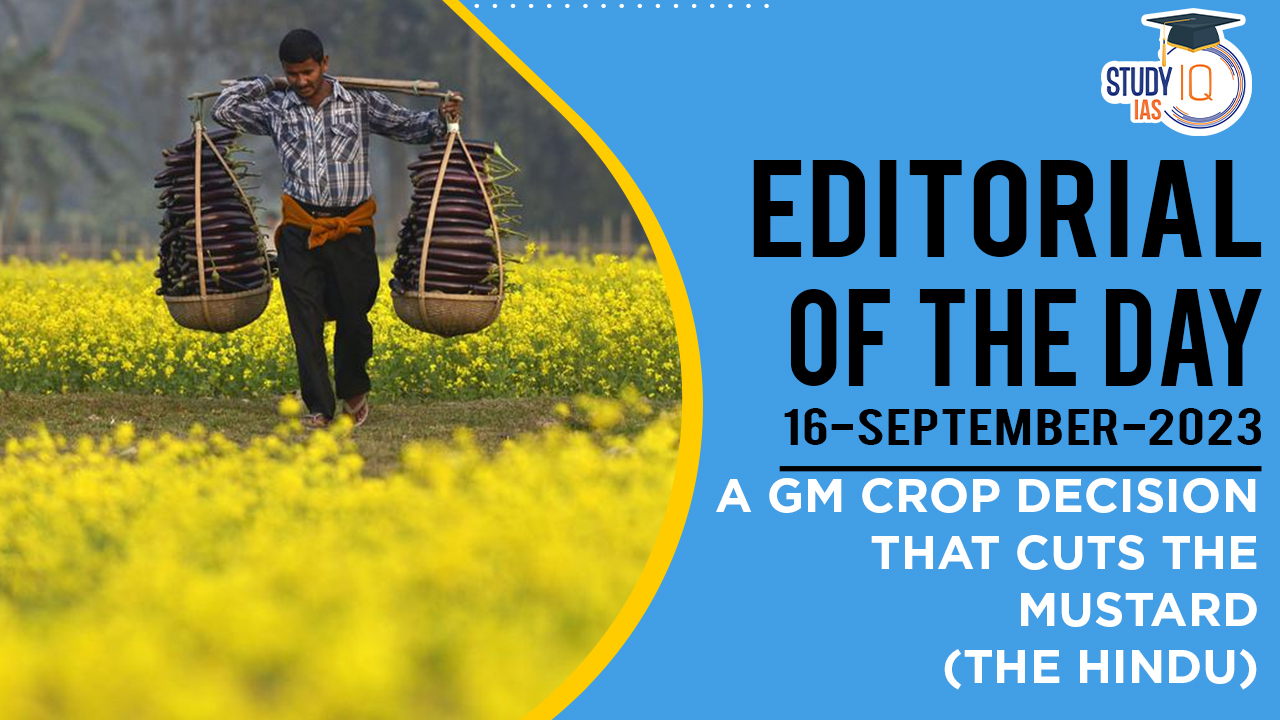Table of Contents
Context: The article is discussing the importance of adopting science-based technologies, particularly genetic engineering, for crop improvement as a means to address the global challenges of achieving food and nutritional security in the face of climate change. It emphasizes the need to accelerate the development of genetically modified (GM) crops alongside conventional breeding methods to increase food production and self-sufficiency. It also suggests that this technology is crucial for India’s agricultural sustainability.
Background
What are GM/transgenic crops?
- Transgenic crops, also known as genetically modified (GM) crops are plants that have been modified through the introduction of genetic material from a different organism.
- The process of creating transgenic crops involves isolating a desirable gene from one organism and inserting it into the genetic material of the target crop plant.
- This gene is selected because it imparts a specific desirable trait, such as resistance to pests, tolerance to herbicides, improved nutritional content, or enhanced productivity.
Transgenic crops (or GM crops) in India
- Bt cotton:
- Bt cotton, the only GM crop that is allowed in India, has two alien genes from the soil bacterium Bacillus thuringiensis (Bt) that allows the crop to develop a protein toxic to the common pest pink bollworm.
- On the other hand, Bt cotton is derived with the insertion of an additional gene, from another soil bacterium, which allows the plant to resist the common herbicide glyphosate.
- Bt Brinjal:
- In Bt brinjal, a gene permits the plant to resist attacks of fruit and shoot borers.
- In 2009, GEAC cleared transgenic Bt brinjal for evaluation. But that effort stalled due to stiff opposition from anti-GMO activists and NGOs.
- DMH 11 Mustard: In October 2022, GEAC has recommended the “environmental release” of the transgenic hybrid mustard DMH-11 for seed production.
- GM soymeal: In April 2022, India has allowed imports of an extra 550,000 tonnes of GM soymeal, to help the poultry industry reeling from a surge in local prices of the important animal feed.
Decoding the Editorial
The article is discussing the following dimensions:
- Global Food Security Challenge: The article acknowledges that achieving the “Zero Hunger” target by 2030, as outlined in global initiatives like the Sustainable Development Goals, is a complex challenge.
- Role of GM Crops: It highlights the role of genetically modified (GM) crops as a supplement to conventional breeding methods in addressing food security challenges. GM crops are seen as a necessity to cope with changing climate conditions.
- Desire for Superior Crop Varieties: It emphasizes the need for superior crop varieties and hybrids that can yield more while requiring fewer natural resources. These crops should be adaptable to various environmental conditions.
- Historical Perspective: It mentions the Green Revolution of the 1960s-70s, which significantly increased global food production. However, it argues that new biotech/GM crops with improved traits are essential to combat climate change and provide nutrient-dense food.
- GM Mustard DMH-11: The article references the environmental release of GM mustard DMH-11 as a significant development in India’s agriculture. This suggests that GM crops are being embraced as a means to achieve self-reliance and sustainability in agriculture.
More crops under GM:
The article discusses the widespread adoption and benefits of genetically modified (GM) crops in agriculture.
- Global Adoption of GM Crops: 72 countries have adopted GM crops. This means that GM crops are being grown, either as human food, animal feed, or for commercial purposes, in a large number of countries around the world.
- Benefits to Developing Countries: 56% of the global GM crop area is in developing countries, and GM crops have benefited over 1.95 billion people, which is 26% of the world’s current population. This means that GM crops are making a significant contribution to food security and economic well-being in many developing nations.
- Success of Bt Cotton in India: Bt cotton is a success story in India, both for farmers and the nation.
- Expansion Beyond Major Crops: Genetic modification has expanded beyond major crops like maize, soybean, cotton, and canola. This means that GM technology is being applied to a wider range of economically important food crops to enhance various traits such as resistance to insects and herbicides, resilience to climate challenges, and improvement in nutritional quality.
- Economic Gains: The global economic gains contributed by GM crops from 1996 to 2018 amounted to $224.9 billion, benefiting more than 16 million farmers, with 95% of them being from developing countries.
- Biosafety: GM food crops have been proven safe for the last 25 years or more. This indicates that extensive research and testing have demonstrated the safety of GM foods for consumption.
Mustard as an edible oil crop:
The article discusses the significance of mustard as an edible oil crop in India and the efforts to increase its productivity through genetic engineering, specifically the development of a genetically modified (GM) mustard hybrid known as DMH-11.
- Edible Oil Deficit in India: India is experiencing a significant shortfall in the production of edible oils, with 60% of its demand being met through imports. This means that the country relies heavily on importing edible oils to meet its consumption needs.
- Importance of Mustard: Mustard is one of the key edible oil crops in India. However, the yield per hectare for mustard in India is relatively low compared to the global average. This low productivity is seen as a challenge, given the high demand for edible oils in the country.
- Genetic Engineering for Higher Yield: The article mentions that extensive research has been conducted at the Centre for Genetic Manipulation of Crop Plants (CGMCP), University of Delhi South Campus, to create a genetically modified (GM) mustard hybrid called DMH-11.
- The goal of this genetic modification is to enhance the yield and vigor of mustard plants.
- This is expected to contribute to increased domestic production of edible oils and, in turn, improve the income of farmers.
- Barnase/Barstar System: The GM mustard hybrid, DMH-11, is based on the barnase/barstar system.
-
- This system involves altering the genetics of mustard plants to remove male fertility in one parent and restore it in the offspring.
- This genetic modification is a key aspect of creating the desired hybrid.
- Herbicide Tolerance Gene: The use of a herbicide tolerance gene as a selection marker in the development of GM mustard serves two primary purposes:
-
- Selecting Genetically Transformed Lines: The herbicide tolerance gene helps identify the mustard plants that have been successfully genetically modified.
- Hybrid Seed Production: It is also used in the production of hybrid seeds, a critical step in maintaining the desired characteristics of the GM mustard.
- Advantages of Herbicide Tolerance: These advantages include saving soil moisture and nutrients and effectively controlling weeds through the use of herbicides.
Aiding self-reliance:
The article discusses a significant decision made by the Genetic Engineering Appraisal Committee (GEAC) of the Ministry of Environment, Forest and Climate Change in India.
- Approval of DMH-11: The GEAC has approved the release of DMH-11, a genetically modified (GM) mustard hybrid, and its parental line for cultivation. This is considered a landmark decision.
- Boost to Genetic Engineering Research: The approval of DMH-11 is seen as a boost to the genetic engineering research sector in India. It is expected to facilitate further research and development in genetic engineering, leading to the creation of new crop varieties with improved traits.
- Narrow Genetic Base of Mustard in India: The mustard varieties in India have a limited genetic diversity. The approval allows for the production of mustard hybrids based on the barnase-barstar system, which can broaden the genetic base and potentially result in mustard hybrids with higher yields, disease resistance, and improved oil quality.
- Benefits to Farmers: The adoption of GM mustard hybrids is expected to benefit farmers by increasing the yield per hectare. This would translate into higher incomes for farmers.
- Potential for Self-Reliance: Cultivating GM mustard hybrids developed within the country is seen as a step toward achieving self-reliance in edible oil production. This means that India could reduce its dependency on expensive edible oil imports and produce more of its own oil domestically.
- Environmental Release of DMH-11: The environmental release of DMH-11 as the beginning of a new era in self-reliance and sustainability in agriculture. This suggests that the approval of this GM crop is viewed as a significant development in promoting agricultural sustainability and self-sufficiency.
- Need for More Improved GM Food Crops: The article concludes by noting that more improved GM food crops are required to enhance the profitability of Indian farmers. This implies that GM technology has the potential to contribute to the economic well-being of farmers in India.
Beyond the Editorial
Benefits of transgenic crops (or GM crops)
- Increased crop yield and productivity: GM crops are often engineered to possess traits that enhance their yield potential. This includes traits like improved resistance to pests, diseases, and environmental stresses, as well as increased tolerance to herbicides.
- Nutritional security: Genetic engineering can be used to improve the nutritional composition of crops. For example, biofortified GM crops can be developed to have higher levels of essential vitamins, minerals, and other nutrients.
- Economic benefits: GM crops can provide economic benefits to farmers, such as increased yields, reduced input costs (e.g., pesticides, herbicides), and improved marketability of their produce.
Concerns with transgenic crops
- Environmental impact: There is a possibility of gene flow from GM crops to wild relatives, leading to unintended effects on biodiversity and ecosystem balance.
- Development of superweeds: There is a risk that genes from GM crops could transfer to related weed species, leading to the development of herbicide-resistant “superweeds.”
- Emergence of insect resistance: The continuous cultivation of GM crops expressing insecticidal traits, such as Bt crops, can lead to the evolution of insect populations that are resistant to the specific toxins produced by the GM crops.
- Human health concerns: Health risks associated with GM foods are concerned with toxins, allergens, or genetic hazards.
- Socio-economic impacts: The adoption of GM crops can have differential impacts on wealthier and poorer farmers, with wealthier farmers more likely to benefit due to their greater financial resources, access to information, and market connections.


 TNPSC Group 4 Admit Card 2025 Out at tnp...
TNPSC Group 4 Admit Card 2025 Out at tnp...
 Species Added to India's Flora and Fauna...
Species Added to India's Flora and Fauna...
 Daily Quiz 02 July 2025
Daily Quiz 02 July 2025





















